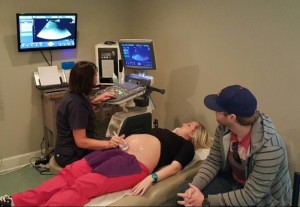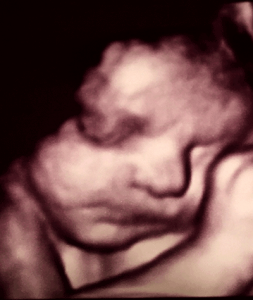3D / 4D Ultrasound
With the newer 3D ultrasound exams, multiple two-dimensional images are taken at various angles and then pieced together to form a three-dimensional rendering. For instance, instead of just seeing a profile view of your cutie’s face, you can see the whole surface (it looks more like a regular photo). A 4D ultrasound exam is similar, but the image shows movement – which means like a video, you see your baby doing things in real time (like opening and closing his eyes and sucking his thumb).
Most 3D/4D images in pregnancy are taken for the enjoyment of parents, rather than for their clinical usefulness. It is a good idea for parents to remember the limitations of 3D/4D when they are having their ultrasound.


3D scans show still pictures of your baby in three dimensions. 4D scans show moving 3D images of your baby, with time being the fourth dimension.
With 3D and 4D scans, you see your baby’s skin rather than her insides. You may see the shape of your baby’s mouth and nose, or be able to spot her yawning or sticking her tongue out.
3D scanning can also be useful to look at the heart and other internal organs. As a result, some fetal medicine units do use 3D scans, but only when they’re medically necessary.
There’s no evidence to suggest that the scans aren’t safe, and most moms-to-be gain reassurance from them. Nonetheless, any type of ultrasound scan should only be performed by a trained professional, for as short a time and at the lowest intensity, as possible.
If you’d like a 3D or 4D scan you’ll probably need to arrange it privately, and pay a fee. The clinic may also give you a recording of the scan on DVD, though this is likely to cost extra.
The special transducers and software required to do 3D and 4D scans are expensive. There are few clear medical benefits, and experts say they should only be done if there’s a medical need. So it’s unlikely that these scans will replace normal 2D scans used for routine maternity care in the NHS.
If you decide to have one, the best time to have a 3D or 4D scan is when you’re between 26 weeks and 34 weeks pregnant.
If the placenta is at the front of your womb (uterus), known as anterior placenta, you’ll get the best images of your baby if you wait until 28 weeks.
It’s natural that you’d like to see your baby’s face on the scan. But sometimes it’s not possible, depending on how she’s lying.
If she’s lying facing outwards, with a good pool of amniotic fluid around her features, you should be able to see her face clearly. But if she’s facing your back, her head’s far down in your pelvis, or there’s not much fluid around her, you won’t see much. The same applies if you have a lot of tummy fat.
It is good for parents to anticipate seeing their growing baby, but not to be too disappointed if the 3D/4D images prove difficult or the images of baby’s face are impossible to get.